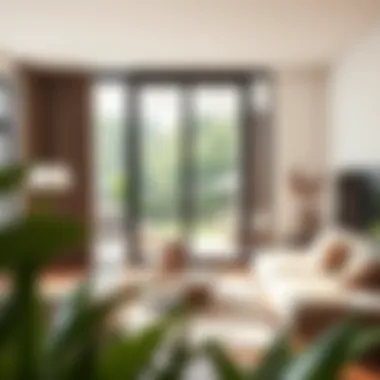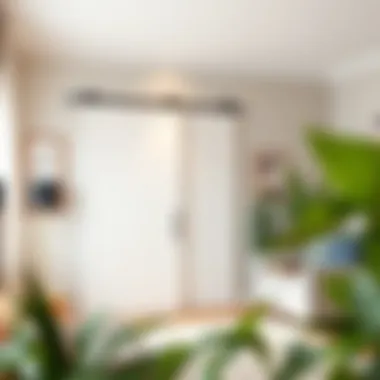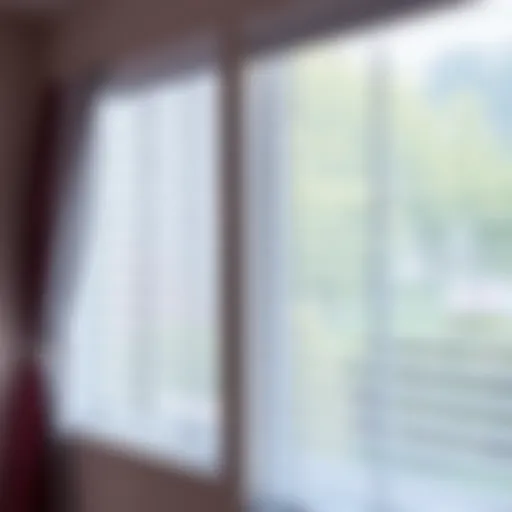The Practical and Aesthetic Benefits of Sliding Privacy Doors


Intro
Sliding privacy doors offer a fascinating blend of functionality and aesthetics that can truly transform modern living spaces. Their ability to create separations without compromising space is undeniable. This article aims to explore several aspects of these versatile installations, delving into their practical benefits and design significance. From material choices to installation tips, the discussions will reveal how these doors can not only elevate privacy but also enhance the overall aesthetic of your home.
Furniture Styles and Trends
Modern vs. Traditional: Understanding the Aesthetics
When talking about sliding privacy doors, one can't ignore the divide between modern and traditional designs. Modern sliding doors, characterized by their sleek lines and minimalist features, often employ materials like glass and metal. They reflect a chic, contemporary feel suited for newly built homes or renovated spaces that lean towards a clean and uncluttered aesthetic.
In contrast, traditional sliding doors evoke a sense of warmth and history. Crafted from wood, often with intricate detailing, these doors can serve as a standout feature in various settings. Homeowners leaning toward a rustic or vintage style might find such options more appealing.
Understanding your home’s style can greatly assist in making the right choice. Here’s a quick rundown:
- Modern Designs: Glass panels, metal accents, open spaces.
- Traditional Designs: Wooden frames, decorative glass, ornate carvings.
Color and Material Trends: What's In and What's Out
With design trends frequently shifting, keeping up with color and material choices is vital. In recent years, we have seen a leaning towards natural materials, particularly wood, which provides an earthy texture that enhances warmth and comfort in spaces. Popular finishes include light oak and walnut, which can blend seamlessly with various décor styles.
Color-wise, muted tones have gained traction. Soft greys, muted blues, and earthy greens resonate well with modern design philosophies focused on tranquility and serenity. On the other hand, vibrant accents can be great for emphasizing modern aesthetics.
Emerging trends include:
- Biophilic Design: Incorporating nature-inspired colors and materials.
- Eco-Friendly Choices: Sustainable materials are becoming increasingly sought after, attracting the environmentally conscious homeowner.
Furniture Care and Maintenance
Tips for Prolonging the Life of Your Furniture
The beauty of sliding privacy doors is not just in their design but also in their longevity when maintained properly. For wooden doors, regular dusting with a soft cloth ensures they remain smooth and free of wear. Additionally, applying a wood conditioner every six months can help keep the material looking fresh and reduce cracking.
For glass sliding doors, it's best to use a gentle glass cleaner to avoid streaks. Frequent cleaning not only maintains their appearance but also prevents grime buildup that can affect safety.
Other essential care tips:
- Keep tracks clean and free of debris.
- Oil rollers periodically to ensure smooth operation.
- Inspect seals regularly to enhance energy efficiency.
DIY Repair Hacks for Common Furniture Issues
Inevitably, there may come a time when a sliding door encounters issues such as misalignment or difficulty sliding. For those who prefer a DIY approach, tackling these problems can be straightforward. Here are some common fixes:
- Misaligned Door: Loosen the screws that hold the roller plate, adjust the position, and then tighten them back.
- Sticking Door: First, clean the track thoroughly. Then, applying a bit of lubricant can assist movement.
- Scratches on Glass: For minor scratches, consider using a glass polishing compound to buff them out gently.
"Investing time in simple repairs can extend the life of your sliding doors significantly, ensuring that both aesthetics and function remain intact."
In summary, the exploration of sliding privacy doors brings forth not just aesthetic appreciation but practical considerations as well. By understanding trends and maintaining these installations, homeowners can fully benefit from their versatility and elegance.
Preamble to Sliding Privacy Doors
The topic of sliding privacy doors holds a significant position in modern home design. As living spaces continue to shrink and personal boundaries become increasingly valued, the demand for effective privacy solutions has surged. Sliding privacy doors serve not just as partitions but as versatile elements that can enhance the home’s aesthetic while maximizing functionality. Understanding their roles opens avenues for creating a harmonious flow between spaces without sacrificing individuality or comfort.
Defining Sliding Privacy Doors
Sliding privacy doors are essentially movable barriers that glide along a track, providing separation while maintaining an open feel. Unlike traditional hinged doors that require ample space to swing, these sliding installations optimize available room, making them ideal for tighter areas. Typically crafted from a myriad of materials ranging from solid wood to sleek glass, they can be tailored to meet particular design preferences and functional needs. In essence, they strike a balance between form and function; practical solutions with a touch of elegance.
Historical Context and Evolution
Historically, the concept of sliding doors can be traced back to various cultures. Japanese Shoji doors, for instance, have long embodied a principle of fluidity and connection with nature. In contrast, Western counterparts gained popularity in the mid-20th century, primarily as a result of increasing urban density and evolving architectural styles. The evolution of materials, too, has played a role. Where once solid wood dominated, today’s options include glass and composites, accommodating a wider spectrum of preferences—from rustic to contemporary.
"Sliding doors represent more than functionality; they embody a blend of tradition and modernity that resonates with diverse aesthetic choices."
As societies have progressed, so have the expectations surrounding these doors. No longer mere functional items, they have become statement pieces, marrying technology and design. The translation from practical solution to artistic endeavor illustrates how adaptation to lifestyle needs can shape home elements, including the sliding privacy door. Their continued evolution highlights a trajectory moving towards increased customization and smarter integrations, making them not just doors, but pivotal elements in modern interior design.
Functional Benefits


Sliding privacy doors come with a variety of functional benefits that cannot be overlooked. These doors are more than just a means to block off areas in your home; they are an integral part of how spaces can be utilized efficiently and aesthetically. In an age where homes are often smaller, clever usage of space becomes critical. Moreover, the balance between design and functionality is something homeowners, designers, and DIY enthusiasts must keep in mind as they choose these doors.
Space Optimization
Space optimization is one of the standout advantages that sliding privacy doors deliver. Traditional doors swing open, needing extra room that often limits how you can position furniture and other decor items. With sliding doors, this barrier is lifted. These doors glide along a track rather than swinging outwards, allowing you to use every inch of your floor space wisely.
In a studio apartment or a compact home, a sliding door can create distinct areas without the bulk. Imagine a small home office that doubles as a spare bedroom—sliding doors can separate these functional spaces with ease, simply by sliding out of sight when not in use. This fluidity accommodates busy lifestyles and shifts in need without significant redesign.
"Space is the final frontier, especially in today's homes. A sliding privacy door can redefine how we perceive it."
Enhanced Privacy Solutions
In a world that often blurs the lines between work, leisure, and personal space, enhanced privacy becomes essential. Sliding privacy doors can provide that needed barrier in an elegant and unobtrusive manner. From a design viewpoint, they can blend seamlessly with any decor style while offering functionality.
For instance, when hosting guests, a sliding door can transform an inviting living area into a more intimate space without the full commitment of a permanent wall. It gives you the flexibility to control privacy levels based on the situation. Whether you need to block out noise from a communal area while working from home or create a secluded space for relaxation, sliding doors are an excellent solution that caters to varying circumstances.
Versatility in Layout Design
Versatility in layout design is where the true magic of sliding privacy doors shines. Unlike fixed walls, these doors offer the freedom to reconfigure public and private spaces according to personal preferences or changing lifestyles. Their ability to blend functionality with creativity opens a realm of design opportunities.
In a modern home, sliding doors can serve a multitude of purposes. They can function as room dividers, provide access to outdoor spaces, or simply act as a way to let in more natural light. For instance, a frosted glass sliding door in between a dining room and a living room can create a sense of openness while still offering a sense of separation when required.
Ultimately, the key to utilizing sliding privacy doors effectively lies in understanding their multifaceted benefits. When thoughtfully implemented, these doors can not only elevate the functionality of your home but also enhance the overall aesthetic appeal, creating spaces that both feel and look good.
Design Options and Aesthetics
The design of sliding privacy doors is a vital aspect that can significantly influence the ambiance and functionality of a space. When it comes to aesthetics and design options, sliding doors aren’t just functional; they also make a bold statement about style and personal preferences. The right choice can elevate your interiors, merging seamlessly with existing decor while also being practical.
Material Choices
Wood
Wood sliding privacy doors are often selected for their warm, natural appeal that lends an inviting touch to any room. They bring a cozy atmosphere, making spaces feel less rigid and more approachable. One of the key characteristics of wood is its versatility—available in countless styles, colors, and finishes, wood can fit into almost any design scheme, from rustic to modern.
A unique feature of wooden doors is their ability to be customized. They can be stained, painted, or left in their natural state, allowing for a personal touch. However, wood can be sensitive to moisture, requiring proper sealing to avoid warping or damage over time.
Glass
When it comes to sliding privacy doors, glass can provide a stunning visual impact while maintaining an open feel. Glass doors are often favored for their capacity to let light flow through while still offering a degree of separation. A characteristic that makes them popular is their sleek, modern aesthetic, which can be a centerpiece of interior design.
However, one must consider the practicality of glass. While it adds elegance and can visually enlarge spaces, it requires regular cleaning to maintain that pristine look. Additionally, unless treated for privacy, clear glass can compromise the very privacy that such doors aim to provide.
Metal
Metal sliding doors, especially those made of aluminum or steel, present a contemporary alternative that's robust and low-maintenance. They are highly durable and resistant to the elements, making them a suitable option for both interior and exterior applications. A notable feature of metal is its fire resistance and strength, providing an impressive sense of security.
That said, metal doesn’t always evoke the warmth of other materials. This material may feel colder and more industrial, which may not align with all design preferences. Selecting finishes can mitigate this, but it’s something worth considering.
Composite Materials
Composite materials have gained attention as a hybrid option that combines elements of wood and synthetic materials. They are designed to offer enhanced durability and stability, making them less prone to the issues that pure wood might face. One of their appeals is that they can mimic the appearance of natural wood, but with added resilience against moisture and pests.
The unique advantage here is durability, often requiring less maintenance than solid wood. However, homeowners should be mindful of their environmental impact; while better than some options, composites can contain plastics, leading to concerns about sustainability.
Finishes and Colors
Natural Finishes
Natural finishes on sliding privacy doors underscore the beauty of the raw material. They often enhance the wood's grain and texture, creating a timeless aesthetic appeal. Because they highlight the inherent beauty of the wood, these finishes can blend harmoniously with both traditional and modern decor styles.
While the uniqueness of natural finishes adds a warm feel, they may require more upkeep compared to painted surfaces, which can weather faster due to exposure to elements unless properly treated.
Painted Options
The charm of painted sliding doors lies in their versatility. With a plethora of color choices available, painted options allow homeowners to express their individual style or harmonize with existing decor. They can serve as bold statement pieces or subtle complements to the overall color scheme of a room.
However, potential downsides include the fact that painted surfaces can chip or scratch, which may necessitate regular touch-ups to maintain their look. Choosing high-quality paint can mitigate this issue and add to the longevity of the visual appeal.


Overlay Designs
Overlay designs infuse personality and creativity into sliding doors, allowing for intricate patterns and textures. These can range from geometric patterns to nature-inspired motifs, adding a standout touch to your interiors. One of the benefits of overlay designs is their ability to transform a simple door into an artistic focal point.
While overlay designs can be visually striking, they can also demand extra attention during cleaning and maintenance, as grooves and recesses might collect dust or grime. The durability of the overlays also matters; ensuring they are crafted with robust materials is key to ensuring longevity.
Integrating Artwork and Custom Designs
Incorporating artwork and custom design elements into sliding privacy doors can not only enhance visual interest but also personalize living spaces. Whether it is etched glass, hand-painted designs, or unique woodwork, the integration of such artistic expressions can make a door an exclusive piece rather than just a functional item.
Custom designs can reflect the owner’s personality or interests, making a statement that transcends basic functionality.
Additionally, custom designs can help to bridge the gap between different areas of the home, creating a cohesive flow between rooms. It’s a way to merge form and function brilliantly. However, customizing a sliding door can come with additional costs, and achieving the desired artistry often requires skilled craftsmanship, so it's important to choose artisans wisely.
Installation Insights
Installing sliding privacy doors is not just about hanging a door on a track; it requires careful thought and strategic planning. Proper installation ensures the doors function smoothly and enhance the living space's aesthetic and practical value. Understanding factors such as space measurement, structural integrity, and track systems is crucial in achieving a seamless look and functionality.
Pre-Installation Considerations
Measuring Spaces
When dealing with sliding privacy doors, measuring spaces accurately might seem like a simple task, but it’s far more complex. It's not just about the door’s width; it’s also about height and the track’s length. Getting those dimensions right is foundational. If the measurements are off, the door won’t fit, leading to costly adjustments and potential issues in functionality.
A key characteristic of measuring spaces is ensuring there’s enough clearance for the door to operate without obstruction. This makes it a beneficial aspect of installation because poor measurements can lead to frustration during use. Moreover, unique features like different wall heights or floor unevenness need consideration. It’s often smart to bring in a professional or someone experienced if you’re unsure about DIY measuring. Plus, the last thing any homeowner wants is a door that sticks or doesn’t close properly.
Structural Integrity
The structural integrity of the area where sliding doors will be installed cannot be overstated. It’s pivotal for the support of the door's weight and for ensuring that the movement is smooth. This includes assessing the strength of walls, the floor's level, and if there’s a need for reinforcements. A solid framework not only guarantees longevity but also enhances safety, especially in larger installations.
One distinct advantage of focusing on structural integrity is preventing future complications such as sagging or misalignment. On the flip side, those who neglect this aspect might face challenges later on, like excessive maintenance or the necessity of repairs. This makes it a critical selection point for any installation project.
Track Systems
Track systems play an integral role in how a sliding privacy door operates, affecting both practicality and aesthetics. There are different types on the market, from double to single tracks. Selecting the right system can enhance the durability and performance of the door, ensuring it glides with ease instead of dragging or getting stuck.
An essential trait of track systems is their compatibility with the door style and available space. Certain systems are made for heavier doors, while others suit lightweight options best. A key advantage is easier access to custom installation, which means homeowners can achieve a look that matches their overall design aesthetic. However, those systems may require more upfront investment and expertise during installation.
DIY vs. Professional Installation
Choosing between DIY and professional installation can be one of the most daunting decisions. DIY can be enjoyable and cost-effective but it can also lead to costly mistakes if done improperly. On the other hand, hiring a professional brings expertise but may strain your budget. Every homeowner needs to weigh their skills against the demands of the installation to make the best choice for their situation.
Maintenance Requirements
Once installed, sliding privacy doors need a regular maintenance routine to keep them looking and functioning their best. This includes cleaning the tracks and checking for any debris that may obstruct movement. A little upkeep goes a long way in ensuring longevity and preventing a breakdown.
While the initial installation can seem daunting, focusing on these installation insights helps facilitate a smooth process. Understanding what’s at stake ensures homeowners not only enjoy aesthetic benefits but also reaps advantages in functionality and value.
Applications in Home Design
Understanding how sliding privacy doors fit into home design is essential for anyone interested in creating adaptable living spaces. These doors serve not just as a barrier but also as an aesthetic and functional element that enhances the overall interior environment. With the right applications, sliding privacy doors can redefine spaces, providing seamless transitions and improved functionality without sacrificing style. The advantages range from optimizing space, to enhancing privacy, ultimately contributing to the home’s aesthetic appeal.
Creating Distinct Living Areas
Sliding privacy doors are excellent for delineating areas within open floor plans. When you have a larger space, like a studio or loft, the challenge often lies in separating functions such as living, dining, and sleeping without creating a claustrophobic feel. These doors can act as mobile partitions, allowing you to create distinct areas at a moment’s notice.
- Flexibility: You can open or close the doors depending on the occasion. Hosting guests? Simply slide the doors aside to create a more open environment. Need some quiet time? Close the doors and enjoy your solitude.
- Visual Appeal: Different materials and finishes provide an opportunity to add character to the interior decor. A wooden sliding door can introduce warmth, while glass options could enhance a modern, airy feel.
"A wise choice of sliding door can turn a straightforward space into a dynamic environment, offering endless possibilities for how the areas within a home can be utilized."
Enhancing Outdoor-Indoor Flow
Another prime application of sliding privacy doors is for enhancing the flow between indoor and outdoor spaces. Think about homes that feature patios or outdoor entertaining areas. By installing sliding doors, you create a more cohesive experience.
- Access to Nature: Sliding doors can lead directly to patios, gardens, or balconies, connecting the comfort of the inside with the serenity of the outside. When opened, they eliminate the barrier between the two spaces, promoting natural light and ventilation.
- Expandable Living Space: When entertaining, these doors can effectively expand your living area. You can move festivities out into the fresh air, enriching gatherings with an inviting atmosphere.


Utilizing in Small Spaces
In smaller homes, sliding privacy doors can be a game changer. Floor space is often at a premium, and traditional swinging doors can encroach on valuable room. Here, sliding doors offer several benefits:
- Maximized Space: Unlike conventional doors, sliding doors do not require clearance for swinging open, freeing up valuable floor space with their sleek, side-to-side operation.
- Illusion of Space: Using glass sliding doors can create a sense of openness in a confined area. The transparency allows light to flow through, making rooms feel larger and more inviting.
Sustainability Considerations
Sustainability has become a cornerstone for nearly every industry, and home design is no exception. As homeowners are increasingly conscious of their environmental impact, the demand for sustainable living solutions has surged. Sliding privacy doors present an opportunity to infuse eco-friendly practices into modern homes without sacrificing style or functionality. When selecting these doors, a deep dive into sustainable materials, energy efficiency, and overall environmental impact is crucial. Not only do these choices cater to the growing preference for green living, but they also lead to long-term financial benefits through energy savings and enhanced property value.
Sustainable Material Options
Choosing sustainable materials for sliding privacy doors is akin to laying a strong foundation for eco-friendly home design. Here are some options that are not only kind to the planet but also aesthetically pleasing:
- Bamboo: Fast-growing and renewable, bamboo boasts durability and a unique texture that adds warmth to any space. Its rapid growth cycle means that it can be harvested in less time than traditional woods, reducing deforestation concerns.
- Reclaimed Wood: This option involves reusing wood from old structures, giving it a new life. Not only does it prevent waste, but it also brings with it a certain character and history that new materials often lack.
- Recycled Glass: Glass doors provide a modern look while being sustainable. Opting for recycled glass reduces waste and minimizes the need for new raw materials.
- Sustainable Timber: Purchasing wood certified by organizations such as the Forest Stewardship Council ensures that it comes from responsibly managed forests, contributing to sustainable forestry practices.
By thoughtfully selecting these materials, homeowners can contribute to reducing waste and lowering their carbon footprint while still achieving a stylish, functional space.
Energy-Efficient Benefits
Another significant consideration when discussing sustainability is energy efficiency. The right sliding privacy doors can act as insulators, maintaining a home's temperature and reducing reliance on heating or cooling systems. Here are key benefits:
- Improved Insulation: Quality sliding doors that feature double or triple glazing can significantly reduce heat loss during winter months and keep indoor spaces cool during the summer. This results in lower energy bills over time.
- Natural Light: With large glass panels, sliding privacy doors maximize natural light, reducing the need for artificial lighting during the day. Brighter spaces not only enhance mood but also lessen energy consumption.
- Airflow Management: When designed properly, these doors can enhance airflow throughout the home, keeping interiors comfortable without heavy reliance on mechanical systems.
Together, the choices made around sliding privacy doors can have a ripple effect on both environmental sustainability and cost efficiency. The benefits extend past the individual home, contributing to a broader commitment to sustainable practices in community development.
Sliding privacy doors represent more than just a stylish choice; they are a pivotal part of a sustainable future in home design.
Future Trends in Sliding Privacy Doors
As we step into an era where homes are increasingly becoming personal retreats, the incorporation of futuristic elements like sliding privacy doors is paramount. These doors not only merge functionality with aesthetics but also adapt to the evolving needs of modern living. We find ourselves in a landscape where the blending of style and technology reigns supreme, creating a significant shift in how we perceive and utilize spaces.
Integration with Smart Home Technology
The rise of smart home technology is reshaping various aspects of how we design our living environments. Sliding privacy doors are no exception to this trend. Imagine sliding doors equipped with sensors that automatically open when you approach them, or even locking mechanisms that can be controlled via a smartphone app. These technological advancements provide convenience and enhance security.
- Automatic Control: With the integration of home automation systems, sliding doors can be synchronized with your home’s lighting or climate control. For instance, a door could automatically close at dusk, ensuring that privacy is maintained while energy consumption is minimized.
- Voice Activation: Voice-controlled systems can allow users to operate their sliding doors effortlessly. Just a simple request, and the door glides open or shut, eliminating the need for physical handling.
- Enhanced Security Features: New locking mechanisms can now alert homeowners if a door is left open or intrusions are detected. This intelligence not only provides peace of mind but also fits into a broader security framework in a smart home setup.
Incorporating such technologies into sliding doors is a game-changer for homeowners, especially those who enjoy a seamless blend of high-end functionality with aesthetic appeal.
Customization and Personalized Solutions
The flexibility in design offered by sliding privacy doors means that homeowners are no longer restricted to standard sizes and styles. Customization is becoming a significant trend as people seek personalized touches to reflect their tastes and lifestyles.
- Tailor-Made Designs: Many manufacturers now offer bespoke options where homeowners can specify dimensions, materials, and finishes to match their decor perfectly. This level of personalization ensures that the doors serve as aesthetic focal points rather than mere functional barriers.
- Artistic Elements: Beyond the practical aspects, homeowners can infuse their own flair into sliding doors. Artwork, etched glass, or unique handles can transform a simple sliding door into a piece of art.
- Color and Finish Variability: With a plethora of colors and finishes, from sleek matte black to vibrant bold hues, individuals can coordinate their doors with their room’s theme. This flexibility allows for more creativity in design choices, transforming spaces into cohesive visuals.
By focusing on customization, sliding privacy doors not only fulfill a practical requirement but also add layers of personality to any home, marrying function with style effortlessly.
"The future of home design is about creating spaces that reflect individual identity while embracing technology."
Through these trends, sliding privacy doors are not just barriers but integral elements of modern home design that adapt to our lifestyles, adding value both functionally and aesthetically. As we advance, it will be exciting to see how these trends evolve further, pushing the boundaries of what sliding doors can achieve.
Culmination
Sliding privacy doors have increasingly become a hallmark of contemporary home design, merging function with aesthetic appeal. Their importance lies not just in their utility but in the subtle transformation they bring to living spaces. As we discussed throughout the article, these doors offer a plethora of benefits, ranging from maximizing space efficiency to providing adaptable privacy solutions.
Recap of Key Insights
Let’s take a moment to recap the key insights surrounding sliding privacy doors:
- Space Optimization: They eliminate the need for swing space, allowing homeowners to make the most of smaller areas.
- Enhanced Privacy Solutions: Whether it's creating a private nook for work or a quiet zone for relaxation, sliding doors achieve this beautifully.
- Versatility in Material and Design: Options range from classic wood to sleek glass, catering to various aesthetic preferences.
- Integration Potential: More than just separators, these doors can anchor various styles, enhancing the flow of outdoor and indoor spaces.
- Sustainability Considerations: With options for eco-friendly materials, homeowners can align their choices with sustainable living practices.
"Sliding privacy doors blur the line between functionality and artistry, making them indispensable in modern architecture."
By recognizing these key elements, it's easier to appreciate how sliding privacy doors are not merely fixtures, but rather pivotal components that shape the overall ambiance and functionality of a home.
The Role of Sliding Privacy Doors in Modern Homes
In the landscape of modern architecture, sliding privacy doors play a vital role. They do more than provide separation; they foster a sense of connection while maintaining necessary boundaries. As homes evolve to embrace open-concept layouts, these doors facilitate flexible living solutions without compromising privacy. They can seamlessly transition living areas to intimate spaces like home offices or reading alcoves.
Moreover, in an era where technology and home automation are on the rise, newer models come equipped with smart features that enhance security and ease of use. This melding of modern technology with traditional design principles underscores the versatility and relevance of sliding privacy doors today.
To sum it up, sliding privacy doors serve as a bridge connecting various aspects of home design, from productivity to aesthetic engagements. The thoughtful integration of these doors into home layouts showcases a homeowner's willingness to embrace innovation while valuing comfort and style.















